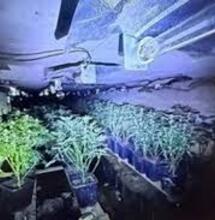Growing in a greenhouse
_11zon_1.png)
With spring out of the way and summer slowly cranking into gear, our thoughts turn to the great outdoors and the possibility of some nice bud grown under that free grow light in the sky. Outdoor crops are awesome, it's almost free weed! However, they do come with their own set of headaches; you have no control over environmental factors like you do indoors, your plants are susceptible to all sorts of pests, disease and, worse still, crop robbers.
With spring out of the way and summer slowly cranking into gear, our thoughts turn to the great outdoors and the possibility of some nice bud grown under that free grow light in the sky. Outdoor crops are awesome, it's almost free weed! However, they do come with their own set of headaches; you have no control over environmental factors like you do indoors, your plants are susceptible to all sorts of pests, disease and, worse still, crop robbers.
Growing in a domestic greenhouse is a great way to utilise the natural light to grow you favourite plants, it offers the grower a level of environmental control and it also negates having to deal with a lot of the problems encountered with guerrilla outdoor grows. Yes, you will still have to fight off pests but they will be of the insect variety rather than rabbits, deers and the local thug’s pit bull!
If you’re growing in a residential area, a greenhouse provides the ideal opportunity to hide a few cannabis plants amongst your veg and herbs, keeping them shielded from the neighbours view and the smell relatively well contained. If you’re in a rural area then there’s no reason not to be a little braver and do a few more plants, just be prepared for the smell. Remember, a carbon filter isn’t an option in a greenhouse, it will fail due to the high humidity levels. Extracting through an in-line ozone generator will be your only option if the smell gets too much.
There are lots of options when it comes to purchasing a greenhouse, the first thing to do is to pick your style; lean-to, free standing or poly tunnel. From experience, we’d recommend against the cheap and cheerful portable greenhouses. They’ll blow away on a windy day and cook your plants on a warm day!
Lean-to greenhouses are assembled against the exterior wall of your house and retain any heat that permeates through the wall. They’re a great option if space is at a premium because they are essentially a ‘half sized’ greenhouse.
Free standing greenhouses are usually apex shaped, like the shape of a house, and can be aluminium or wood framed. One important point to remember is that, the larger the frame, the larger the shadows they will cast over your plants.
Poly tunnels are traditionally used in commercial horticulture but are also available in domestic sizing. They consist of a curved aluminium frame with polythene sheeting stretched over it to form a solid structure. They’re usually cheaper than traditional greenhouses, but the sheeting will need replacing every 3-5 years.
Unless you’re very tight on space for your greenhouse, it’s a good idea to buy the next size up from the size you were going to buy. It’s nice to have some space to work and move around in. Plus, you’ll always fill any unused space with equipment and growing media.
Whatever size and style of greenhouse you decide on, it’s best to go for a diffused or semi-diffused coverings or panels, rather than clear panels. Clear panels deliver direct light, which is great for propagating or bringing on young plants, as the direct sun will keep everything warm and prevent seedlings from getting leggy.
However, to grow your plants full cycle you really need to diffuse the light to stop all the plants fighting for the light and also prevent hot spots from forming. Diffused light encourages even growth throughout your full crop and will increase your average yield.
Overheating is one of the main causes of plant failure in greenhouses. A greenhouse must retain warm air during the cooler months, but it’s equally as important to release hot air during the warm months. When choosing a greenhouse, give consideration to ventilation. The glazing must have vents to ensure good growing conditions. The combined area of all the vents when open should be at least a fifth of the floor area. There should be sufficient allowance for air to enter and exit the structure. Look for vents near the top of the structure and base vents for air intake.
In addition to manually operated vents, it is worth paying for an automatic vent opener. This contains a cylinder of wax that expands and opens the vent when it’s warm, then closes it again when it’s cooler. This lets you be away from the greenhouse without having to worry about your plants sweltering during the hottest parts of the day. Some greenhouse designs also feature exhaust fans to prevent overheating during spring and summer months.
Once you’ve chosen your greenhouse, it’s time to pick the right spot to set it up in. Ideally, your plants will need 5-7 hours of direct sunlight per day. This will be achieved with a south facing spot. The more direct sunlight the plants get, the better the yields you’ll harvest.
Morning dew will tend to get trapped in buds and may form mould over time, so direct sun from as early in the day as possible will minimise the moisture trapped in the buds and will reduce the risk of bud rot. Of course, this will only work if you have adequate ventilation in your greenhouse.
So, you’ve got your greenhouse sorted, now what are you going to grow? If you’ve got your heart set on a regular photoperiod strain then you should know that the outdoor growing season lasts from April through to November, with the majority of strains ready to harvest from mid to late October. You will get one crop during this growing period.
Seeds should be sown in early April, so that they are ready for moving outdoors from mid-May to early June. Start them indoors under a regular propagation light. As you get closer to the date that they will transplanted to your greenhouse, harden them off by taking them outside for a few hours a day; increase the amount of time they spend outside to get them acclimatised to the outside temperatures.
The plants will vegetate through the months of May and June and will be triggered into the flowering photo period after the summer solstice – the longest day of the year – this is when the amount of daylight hours gets progressively shorter and the plants instinct is to put out flowers – buds – in order to reproduce.
Most strains will take between 8 and 12 weeks to finish flowering, meaning that crops will be ready to harvest between the end of September to the start of November.
Be warned that regular photoperiod strains can get HUGE when grown outdoors and it’s very easy to run out of head room in a small greenhouse, so you’ll need to spend time topping and training your plants.
For growing in a domestic sized greenhouse in UK weather conditions, it’s a good idea to look at autoflowering strains. Autoflowers are great for outdoor growing in the UK. For those of you that don’t know, they are a non-photoperiod sensitive variety of Cannabis which - in layman’s terms - means that you don’t have to rely on the days getting shorter in order to get them to flower. They will automatically start to produce bud sites and begin flowering two to three weeks after germination, regardless of the amount of light hours they receive.
This makes them a safe bet for producing some decent greenhouse weed, because you can basically plant them out when the weather is already nice and warm, safe in the knowledge that they’ll be ready to harvest within 60 to 90 days. Yes, it’s true that the plants will be smaller and produce a lesser yield than regular photoperiod sensitive varieties, but at least you’ll be guaranteed an outdoor harvest.
The fact that autos are quicker to finish means that you’ll be able to pull off more outdoor harvests over the year, because autos begin flowering automatically, growing outdoors and starting a crop early in the year (weather permitting) means that you’ll be harvesting in the middle of summer. Overlapping your planting and harvest times by a few weeks or so means that, even in the UK, you could easily pull 3 outdoor harvests in a year! Or keep adding new plants to your greenhouse every few weeks and you’ll be harvesting on a regular basis come the end of the summer. The short growth cycle also allows you to start an outdoor crop later in the year. So, if we have a poor spring you can plant well into the summer months and still pull an outdoor harvest.
Attention northern growers! If you’re situated in Ireland, the North of England or Scotland you can easily pull off a greenhouse crop. The Cannabis Ruderalis influence in the genetics of auto strains means that they are more resistant to the cold weather, disease and moulds (they grew up in Russia and Siberia after all!). Very handy for UK greenhouse growing.
Just as with regular photoperiod strains, your plants will need to be started off indoors, but this doesn’t mean you’ll need to splash out on a full grow room set up. You can get everything you need for a few quid. Get yourself a cheap high dome propagator, some light mix soil, some 10cm pots and a single T5 strip light. Sow your seeds in the pots filled with light mix, wait for them to germinate and then bring them on for a few days under the T5 lamp.
Then you’ll need to harden them off for a few days; remove the propagator lid and keep the T5 just above the tops of your babies. Finally, it’s time to get them ready to go into the greenhouse.
One of the big selling points with growing autos in your greenhouse, is that they will stay small in size. ‘Dwarf’ or ‘Low Ryder’ varieties of auto will reach no more than a foot and a half in height. Most of the auto strains (with the exclusion of the ‘Super Autos’) will remain small. This is perfect for hiding your plants in amongst pots filled with herbs or veg. Even better would be to grow the autos along the centre of the greenhouse and place some vine plants, like tomatoes and cucumbers, up the sides of the greenhouse, this will break up the silhouette of the cannabis plants and keep them hidden from the neighbours.
After you’ve chosen your seeds, the only decision left to make is how you’ll actually cultivate your greenhouse plants. If you decide to hand feed then planting out in large pots of soil or coco will cut down on the watering workload and also ensure that there is plenty of moisture available to the roots during warm days. As the plants are undercover, you are free to choose whichever nutrient schedule you wish, organic or mineral, safe in the knowledge that your expensive nutrients won’t get washed out of the pots by the rain.
It’s tempting to run mains power into your greenhouse to power a hydroponic system but, before you do, take a look at the possibilities offered by some of the better passive hydroponic systems; they operate without pumps, timers or electricity, and they’ll equal the yields of traditional hydroponics.
For example, Hempy buckets are single plant systems that are very cheap to build and offer great results. Take a look at our guide to building them back in 2014 UK issue 1. The AutoPot systems are modular and can be expanded from a single pot to thousands of pots, they’re used in commercial greenhouses across the world and are well worth a look.
In fact, passive hydro systems can be better suited to greenhouse growing than systems that run on a pump and timer. This is because passive systems make nutrient and water available to the plant at all times, they drink when they need it, and the amount they drink is dependent on the weather. If it’s hot they will drink lots, if it’s cool they’ll drink much less. If you feed your plants on a pump and timer under the same conditions, they may end up under fed when it’s hot and overfed when it’s cold.
There’s still time this year to pick yourself up a greenhouse and get an auto crop on the go, don’t just take our word for it, try it for yourself!
Happy growing!



